
Alaska: Alaska Wilderness Spectacular - Cruisetour 8B (Pre Tour)
Royal Caribbean®
See more of Alaska's spectacular scenery in unrivaled comfort traveling the full length of the Alaska Railroad in the glass-domed railcars of The Wilderness Express.

Executive Member Benefit
Executive Members receive an annual 2% Reward, up to $1,250, on qualified Costco Travel purchases
Digital Costco Shop Card
Member Exclusive: Digital Costco Shop Card with every Royal Caribbean® sailing†
Tour Highlights
From the airport, your transfer (included) brings you to your hotel to meet your Adventure Specialist. The Golden Heart City is then yours to explore. Overnight at Sophie’s Station Suites. *Alaska Cruisetour arrival times are tentative. The tour component of your escorted Cruisetour vacation is comprised of tour guide escort, included experiences, lodging and transportation as described. Optional excursions are not included. Meals are not included unless specified as an inclusion.
Spend the day exploring local history, heritage and culture, beginning with a city highlights tour and a visit to the Museum of the North. Enjoy free time downtown for lunch and shopping, then embark on a cruise on the Chena River aboard an old-fashioned sternwheeler. From 6:00 p.m., your time in Fairbanks is your own. Enjoy a hearty frontier meal at a local restaurant or at a dinner theater that tells the story of the gold rush through musical comedy (additional fees apply). Overnight at Sophie’s Station Suites.
Take in the spectacular scenery from the glass-domed railcars of the Wilderness Express® on the train trip to Denali. From 3:30 p.m., the wonders of Denali are yours to explore. Your Adventure Specialist can recommend optional excursions, from guided hikes to adventures like flightseeing trips or rafting down the Nenana River (additional fees apply). Overnight at Denali Park Village.
The Tundra Wilderness Tour takes you deep into Denali National Park along its lone road for the best chances at seeing wildlife. After your tour, spend time at the museum-like visitor center or take advantage of the biking and hiking trails that begin near the park entrance. Overnight at Denali Park Village.
There's time to walk the trails around the lodge before boarding the Wilderness Express® heading to Talkeetna. From 5:00 p.m., enjoy a free evening in this funky small town. Locals and visitors mix and mingle in the restaurants, brew pubs, cafes and shops along the historic main street. Overnight at the Talkeetna Alaskan Lodge.
The day is free for your style of adventure in this hub for outdoor fun. Your Adventure Specialist can recommend optional activities like flightseeing, river rafting and more (additional fees apply). Then relax and take in the views from the Wilderness Express® on the scenic rail journey into Anchorage. From 8:00 p.m., experience big-city nightlife under the evening sun, with restaurants, craft breweries and urban trails all part of the eclectic scene. Overnight at the Anchorage Marriott.
Discover the state's diverse indigenous traditions on a guided tour of the Alaska Native Heritage Center. Then enjoy free time downtown for lunch, shopping or just strolling around before the drive along the Turnagain Arm and Chugach Mountains to the coast. Your Adventure Specialist will wish you bon voyage as you say goodbye at the ship terminal.
Onboard the Ovation of the Seas
Ovation of the Seas
Year Built: 2016
Double Occupancy Capacity: 4430
Go scenery scoping from the unrivaled perspective of the North Star®, the highest vantage point on any cruise ship. Gaze at brilliant blue glaciers and majestic waterfalls from the pool deck as you sail through Endicott Arm. Then refuel with delicious, globally inspired dishes and robot-crafted cocktails as fresh as the crisp mountain air outside. And in between adventures onshore, fill each sea day with thrilling activities like surf sessions on the FlowRider®, simulated skydiving on RipCord®by iFLY®, and so much more.
Activities & Services (included in cruise)
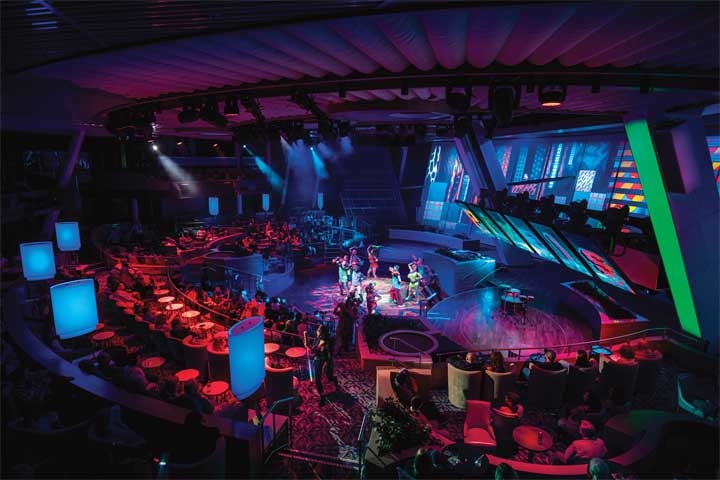
Two70 Theater
- Card Room
- Casino
- Disco/Nightclub
- Movies
- Theater/Show Lounge
- Fitness Center
- Pool - Adults Only
- Pool - Children's
- Pool - Outdoor
- Pool - Indoor/Covered
- Rock-Climbing Wall
- Sports Facilities
- Water Slide
- Whirlpool/Jacuzzi
- Bumper Cars
- Roller Skating
- RipCord by iFLY® Skydiving Simulator
- NorthStar℠ (select times)
- FlowRider® surf simulator
- Art Gallery
- Internet Center
- Children's Indoor Play Area
- Educational Classes
- Educational Programs
- Organized Age Specific Activities
- Teen Center or Disco
- Teen Programs
- Concierge Desk
- Duty-Free Shops/Boutiques
- Elevators
- Religious Services
- Safe Deposit Boxes
Activities & Services (available for an extra fee)
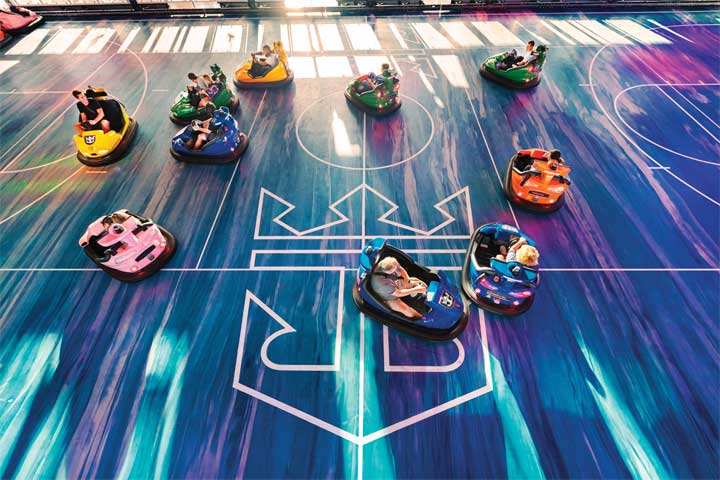
Bumper Cars
- Game Arcade
- Beauty Salon
- Fitness Classes
- Full-Service Spa
- Spa Services/Massage
- Library
- Dry Cleaning/ Laundry Service
- Infirmary/Medical Center
- Wedding/Vow Renewal
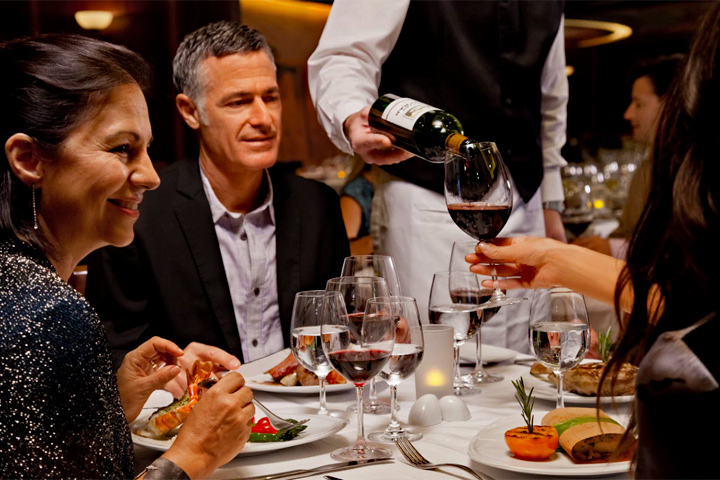
Main Dining
Main Dining
Main Dining Room: Sweeping, multi-level ambience, world-class cuisine and extraordinary personal service from a dedicated wait staff. Royal Caribbean's main dining room serves exceptional, multi-course meals for breakfast, lunch and dinner.
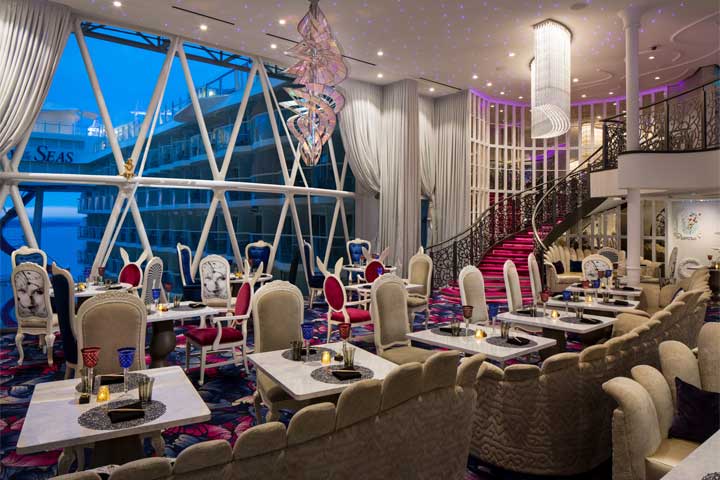
Wonderland
Specialty Dining
Chef's Table: A once-in-a-lifetime culinary experience – join guests in an exclusive enclave to savour a five-course, gourmet menu specially prepared and presented by the Chef de Cuisine. Every course pairs with a wine chosen to enhance your enjoyment of the dish. The menu, wine selections and price vary from ship to ship and itinerary. This restaurant is available for an additional cost.
Chops Grille℠: Royal Caribbean's popular signature steakhouse, featuring grade-A premium cuts of steak cooked to your specifications, plus fresh seafood, hearty side dishes and signature desserts in an upscale, contemporary setting. This restaurant is available for an additional cost.
Coastal Kitchen: Exclusively for suite guests and Pinnacle Club members, Coastal Kitchen fuses Mediterranean influences with farm-fresh flavors from California. Filled with Pacific Coast favorites and Med-inspired entrees, the menu here rotates to spotlight delicious, seasonal ingredients. And you can pair every bite with a glass or bottle of wine off a list that includes vintages from the sun-kissed valleys of Napa to the golden-green hills of Tuscany. This restaurant is available for an additional cost.
Fish & Ships℠: Order up batter-fried favorites at Fish & Ships℠ — the new seafood spot that's just within splashing distance of the pool. This restaurant is available for an additional cost.
Izumi: The traditional Japanese dishes at Izumi will impress you with pure, delicate flavors, freshness of ingredients and impeccable presentation. Choose from sushi rolls, sashimi and more. This restaurant is available for an additional cost.
Jamie's Italian by Jamie Oliver: Chef Jamie Oliver may be one of Britain’s most famous food exports, but it’s his intense passion for Italian cooking and the Italian way of life that drives the menu at Jamie’s Italian. This restaurant is available for an additional cost.
La Patisserie: Fuel your morning at La Patisserie. This café-style eatery, exclusively available upon Quantum Class ships, serves up coffee and pastries and is ideal for an on-the-go breakfast. This restaurant is available for an additional cost.
Wonderland: Our chefs twist their culinary kaleidoscopes to invent an elaborate dreamscape of never-before-seen fare. The story begins as you open the menu and find your element - Sun, Ice, Fire, Water, Earth and Dreams. This restaurant is available for an additional cost.
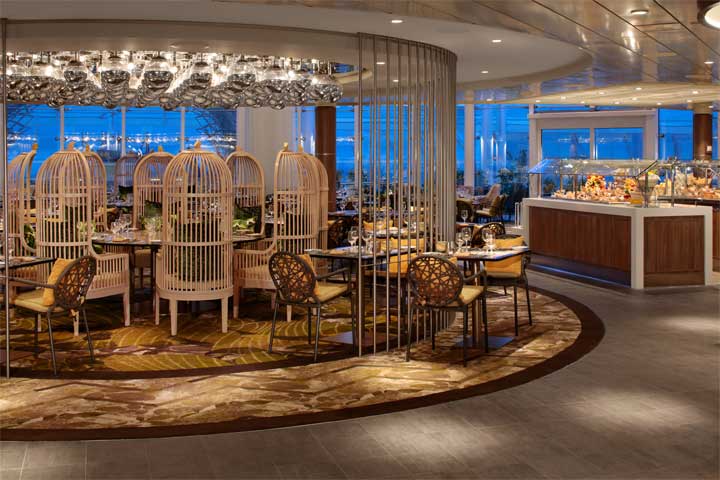
Solarium Bistro
Casual Dining
Café Promenade: The multi-level Royal Promenade is the heart of our ships – and the best spot for people watching. Pick a table with a view at Café Promenade, serving Starbucks or illy coffee, snacks, pastries and sandwiches throughout the day and into the night – so you can enjoy the action when you please.
Dog House: How do you build your dog? Take a seat at the counter for traditional hot dogs, brats, sausages and other delicious linked meats, plus a variety of toppings to split a long bun.
Solarium Bistro: A hearty but healthful lunch destination in Solarium with lighter options for breakfast and lunch. Try soups and stews, crepes, salad bars, fresh-cut fruits and more.
Sorrento's Pizza: For an authentic New York pizzeria experience, head to Sorrento's for fully-loaded pies right out of the oven. Sample rotating creations from chorizo to Hawaiian to Pizza Florentine – with classic cheese and pepperoni always on call.
The Café @ Two70°: The Café @ Two70° is a gourmet marketplace that lets you pick the view. Choose from a variety of savory hot-pressed sandwiches, salads custom-made to your liking, homemade soups and more.
Windjammer Café: A culinary destination loaded with an array of delicious food for every meal and snack time – all with spectacular views and a comfortable, casual atmosphere. Browse multiple serving stations featuring pastas, omelettes made-to-order, global cuisine, salads, soups, sandwiches, meat-carving, and tons of tantalizing desserts.
Room Service: Room service is available 24-hours a day (a convenience charge applies to each order placed).
Interior staterooms include a wide array of amenities for your whole family to enjoy.
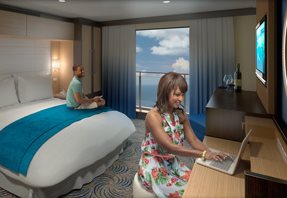
Category: 2W
- Sized perfectly for solo adventurers
- One of our most budget-friendly options
- Same amenities as all other staterooms
Beds
- One full-size bed
Size
- Stateroom: 101 sq. ft.
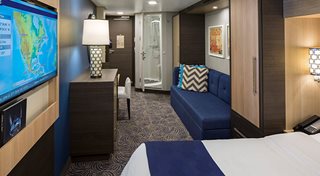
Category: CI
- Connects to the room next door
- Get "double" the space when booking both
- Great for families
Beds
- One Royal King bed (can convert into two twin-size beds)
Size
- Stateroom: 166 sq. ft.
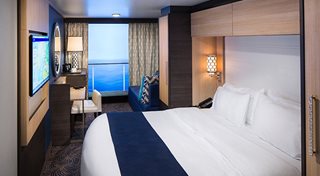
Category: 1U
- A high-definition screen inside your stateroom
- Brings a live ocean view right to you
- Views of a balcony stateroom at the price of an interior
Beds
- One Royal King bed (can convert into two twin-size beds)
- One double sofa bed in staterooms with up to 4 guests
Size
- Stateroom: 166 sq. ft.

Category: 2U
- A high-definition screen inside your stateroom
- Brings a live ocean view right to you
- Views of a balcony stateroom at the price of an interior
Beds
- One Royal King bed (can convert into two twin-size beds)
- One double sofa bed in staterooms with up to 4 guests
Size
- Stateroom: 166 sq. ft.

Category: 3U
- A high-definition screen inside your stateroom
- Brings a live ocean view right to you
- Views of a balcony stateroom at the price of an interior
Beds
- One Royal King bed (can convert into two twin-size beds)
- One double sofa bed in staterooms with up to 4 guests
Size
- Stateroom: 166 sq. ft.

Category: 4U
- A high-definition screen inside your stateroom
- Brings a live ocean view right to you
- Views of a balcony stateroom at the price of an interior
Beds
- One Royal King bed (can convert into two twin-size beds)
- One double sofa bed in staterooms with up to 4 guests
Size
- Stateroom: 166 sq. ft.

Category: ZI
This category can be booked for a special rate, guaranteed to you. Please note that the category is not associated at the time of booking with a specific stateroom, deck, bedding configuration or other particular settings. The assignment of an actual cabin will be performed during your check-in. The cabin can be anywhere on the ship.

Category: ZQ
This category can be booked for a special rate, guaranteed to you. Please note that the category is not associated at the time of booking with a specific stateroom, deck, bedding configuration or other particular settings. The assignment of an actual cabin will be performed during your check-in. The cabin can be anywhere on the ship.
Spectacular sights and amazing views from the comfort of your stateroom.
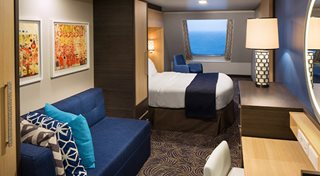
Category: 3M
- Extra square footage at a great value
- Perfect if you need that little extra space
- Your very own in-stateroom window
Beds
- One Royal King bed (can convert into two twin-size beds)
- One double sofa bed in staterooms with up to 4 guests
Size
- Stateroom: 214 sq. ft.

Category: 4M
- Extra square footage at a great value
- Perfect if you need that little extra space
- Your very own in-stateroom window
Beds
- One Royal King bed (can convert into two twin-size beds)
- One double sofa bed in staterooms with up to 4 guests
Size
- Stateroom: 214 sq. ft.
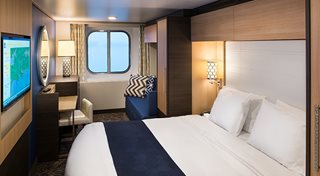
Category: 1N
- Budget-friendly with a view of the ocean
- Your very own in-stateroom window
- Great for families with small children
Beds
- One Royal King bed (can convert into two twin-size beds)
- One double sofa bed in staterooms with up to 4 guests
Size
- Stateroom: 182 sq. ft.

Category: 2N
- Budget-friendly with a view of the ocean
- Your very own in-stateroom window
- Great for families with small children
Beds
- One Royal King bed (can convert into two twin-size beds)
- One double sofa bed in staterooms with up to 4 guests
Size
- Stateroom: 182 sq. ft.

Category: YO
This category can be booked for a special rate, guaranteed to you. Please note that the category is not associated at the time of booking with a specific stateroom, deck, bedding configuration or other particular settings. The assignment of an actual cabin will be performed during your check-in. The cabin can be anywhere on the ship.

Category: YQ
This category can be booked for a special rate, guaranteed to you. Please note that the category is not associated at the time of booking with a specific stateroom, deck, bedding configuration or other particular settings. The assignment of an actual cabin will be performed during your check-in. The cabin can be anywhere on the ship.
Enjoy the ambiance of our neighborhood balcony staterooms that overlook the Central Park and Boardwalk neighborhoods or take in breathtaking views from your Ocean View balcony stateroom.
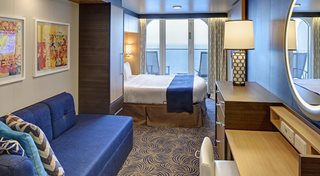
Category: CB
- Balcony stateroom that connects to the room next door
- Get "double" the space by booking both
- Great for families
Beds
- One Royal King bed (can convert into two twin-size beds)
Size
- Stateroom: 198 sq. ft.
- Balcony: 55 sq. ft.
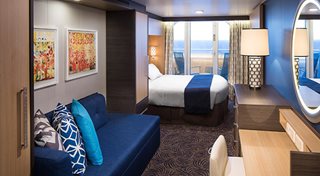
Category: 1E
- Our standard balcony stateroom
- Pristine views of the ocean
- Private balcony with chairs
Beds
- One Royal King bed (can convert into two twin-size beds)
- One double sofa bed in staterooms with up to 4 guests
Size
- Stateroom: 198 sq. ft.
- Balcony: 55 sq. ft.

Category: 2E
- Larger than standard balcony
- Private balcony with chairs
- Extra square footage to relax on your balcony
Beds
- One Royal King bed (can convert into two twin-size beds)
- One double sofa bed in staterooms with up to 4 guests
Size
- Stateroom: 198 sq. ft.
- Balcony: 65 sq. ft.
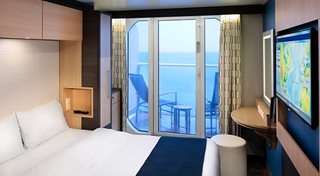
Category: 2F
- Sized perfectly for solo adventurers
- One of our most budget-friendly options
- Same amenities as all other staterooms
Beds
- One full-size bed
Size
- Stateroom: 119 sq. ft.
- Balcony: 55 sq. ft.
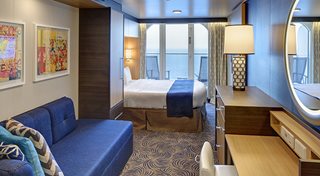
Category: 1D
- Our standard balcony stateroom
- Pristine views of the ocean
- Private balcony with chairs
Beds
- One Royal King bed (can convert into two twin-size beds)
- One double sofa bed in staterooms with up to 4 guests
Size
- Stateroom: 198 sq. ft.
- Balcony: 55 sq. ft.

Category: 2D
- Our standard balcony stateroom
- Pristine views of the ocean
- Private balcony with chairs
Beds
- One Royal King bed (can convert into two twin-size beds)
- One double sofa bed in staterooms with up to 4 guests
Size
- Stateroom: 198 sq. ft.
- Balcony: 55 sq. ft.

Category: 3D
- Our standard balcony stateroom
- Pristine views of the ocean
- Private balcony with chairs
Beds
- One Royal King bed (can convert into two twin-size beds)
- One double sofa bed in staterooms with up to 4 guests
Size
- Stateroom: 198 sq. ft.
- Balcony: 55 sq. ft.

Category: 4D
- Our standard balcony stateroom
- Pristine views of the ocean
- Private balcony with chairs
Beds
- One Royal King bed (can convert into two twin-size beds)
- One double sofa bed in staterooms with up to 4 guests
Size
- Stateroom: 198 sq. ft.
- Balcony: 55 sq. ft.

Category: XB
This category can be booked for a special rate, guaranteed to you. Please note that the category is not associated at the time of booking with a specific stateroom, deck, bedding configuration or other particular settings. The assignment of an actual cabin will be performed during your check-in. The cabin can be anywhere on the ship.

Category: XQ
This category can be booked for a special rate, guaranteed to you. Please note that the category is not associated at the time of booking with a specific stateroom, deck, bedding configuration or other particular settings. The assignment of an actual cabin will be performed during your check-in. The cabin can be anywhere on the ship.
Exclusive experiences, inclusive amenities, luxury accommodations and more.
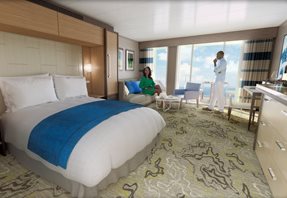
Category: RL
- Expansive two-floor suite with ample space for everyone
- Most luxurious suite on the Royal Caribbean fleet
- Star Class amenities
Beds
- One King-size bed
- One Royal King Bed (can convert into two twin-size beds)
- One double sofa bed
Size
- Stateroom: 1,640 sq. ft.
- Main Balcony: 553 sq. ft.
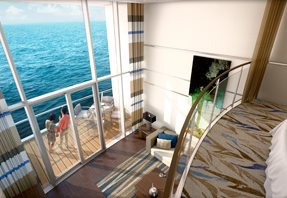
Category: OL
- Extra-large loft suite with spacious living area and balcony
- Upper-level master bedroom overlooks the living room
- Star Class amenities
Beds
- One King-size bed
- One double sofa bed
Size
- Stateroom: 975 sq. ft.,
- Balcony main level: 501 sq. ft.
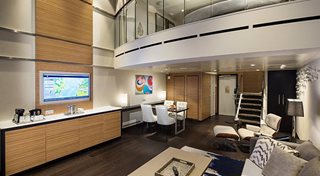
Category: GL
- Extra-spacious stateroom and balcony
- Upper-level master bedroom overlooks the living room
- Star Class amenities
Beds
- One King-size bed
- One double sofa bed
Size
- Stateroom: 696 sq. ft.
- Balcony: 216 sq. ft.
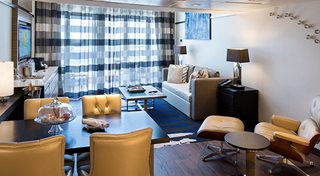
Category: SL
- Two-floor suite
- Upper-level master bedroom overlooks the living room
- Sky Class amenities
Beds
- King-size bed
- One double sofa bed
Size
- Stateroom: 673 sq. ft.
- Balcony: 183 sq. ft.

Category: OS
- Larger and more luxurious than our one bedroom Grand Suites
- Put the extra square footage to use as you kick back and relax
- Sky Class amenities
Beds
- One Royal King bed (can convert into two twin-size beds)
- One double sofa bed
Size
- Stateroom: 541 sq. ft.
- Balcony: 259 sq. ft.

Category: GT
- High-occupancy two-bedroom suite
- Perfect for groups or families
- Sky Class amenities
Beds
- Two Royal King beds (each can convert into two twin-size beds)
- One double sofa bed
- Two fold-down Pullman beds
Size
- Stateroom: 543 sq. ft.
- Balcony: 259 sq. ft.
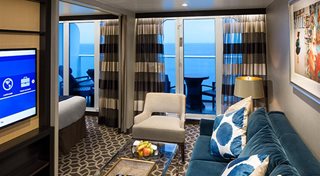
Category: GB
- Enjoy a Grand Suite with an even bigger balcony
- Take in stunning ocean views with extra real estate
- Sky Class amenities
Beds
- One Royal King bed (can convert into two twin-size beds)
- One double sofa bed
Size
- Stateroom: 351 sq. ft.
- Balcony: 259 sq. ft.
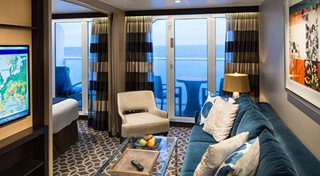
Category: GS
- Ample space, including a living room and full bathroom with a tub
- "Grandest" suite in the fleet
- Sky Class amenities
Beds
- One Royal King bed (can convert into two twin-size beds)
- One double sofa bed
Size
- Stateroom: 351 sq. ft.
- Balcony: 109 sq. ft.
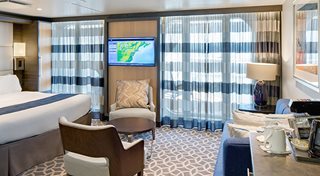
Category: J1
- Same as our standard Junior Suite, but with a larger balcony
- Private balcony with two chairs
- Sea Class Suite amenities
Beds
- One Royal King bed (can convert into two twin-size beds)
- One double sofa bed
Size
- Stateroom: 276 sq. ft.
- Balcony: 161 sq. ft.
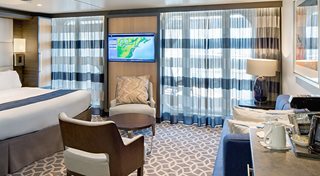
Category: J3
- Our standard suite for luxury on a budget
- Private balcony with two chairs
- Sea Class amenities
Beds
- Two Royal King beds (each can convert into two twin-size beds)
- One double sofa bed in staterooms with up to 4 and 5 guests
- One fold-down Pullman bed in staterooms with up to 5 guests
Size
- Stateroom: 267 sq. ft.
- Balcony: 81 sq. ft.

Category: J4
- Our standard suite for luxury on a budget
- Private balcony with two chairs
- Sea Class amenities
Beds
- Two Royal King beds (each can convert into two twin-size beds)
- One double sofa bed in staterooms with up to 4 and 5 guests
- One fold-down Pullman bed in staterooms with up to 5 guests
Size
- Stateroom: 267 sq. ft.
- Balcony: 81 sq. ft.

Category: JY
- Our standard Junior Suite with extra perks
- Private balcony with chairs
- Sky Class amenities
Beds
- One Royal King bed (can convert into two twin-size beds)
Size
- Stateroom: 267 sq. ft.
- Balcony: 81 sq. ft.

Category: WS
This category can be booked for a special rate, guaranteed to you. Please note that the category is not associated at the time of booking with a specific stateroom, deck, bedding configuration or other particular settings. The assignment of an actual cabin will be performed during your check-in. The cabin can be anywhere on the ship.

| Symbol | Description |
|---|---|
 | Stateroom for occupancy 5 and up |
 | Stateroom for occupancy up to 4 |
 | Accessible stateroom |
 | Stateroom has an obstructed view |
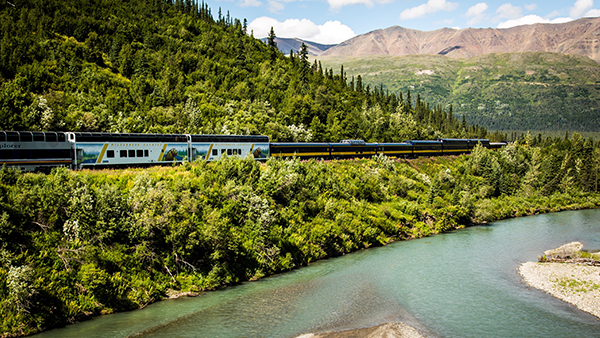
- Ship Name: Ovation of the Seas
- Year Built: 2016
- Year Entered Present Fleet: 2016
- Ship Class: Quantum
- Maximum Capacity: 4,905
- Number of Passenger Decks: 16
- Number of Crew: 1,500
- Officers' Nationality: Norwegian
- Ocean-View without Balcony: 148
- Ocean-View with Balcony: 1,446
- Total Inside Staterooms: 375
- Tonnage (GRT): 168,666
- Capacity Based on Double Occupancy: 4,430
- Country of Registry: The Bahamas
- Total Staterooms: 2,091
- Suites with Balcony: 125
- Crew/Hotel Staff Nationality: International
Costco Member Reviews

Available Dates & Prices
Terms & Conditions
*Price shown is per person based on double occupancy and is valid for select stateroom categories only. Click on the Terms & Conditions link below for details.
†One Digital Costco Shop Card per room/stateroom, per stay. The exact amount of the Digital Costco Shop Card will be calculated during the booking process. The Digital Costco Shop Card promotion is nontransferable and may not be combined with any other promotion. A Digital Costco Shop Card will arrive by email approximately 10 days after the start of your cruise. Click on the Terms & Conditions link below for additional information.
Ship's registry: The Bahamas
Digital Costco Shop Card
Book this vacation or cruise with Costco Travel and receive a Digital Costco Shop Card. The Digital Costco Shop Card is a convenient payment option in our warehouses and on Costco.ca.







